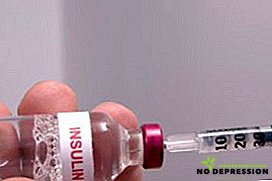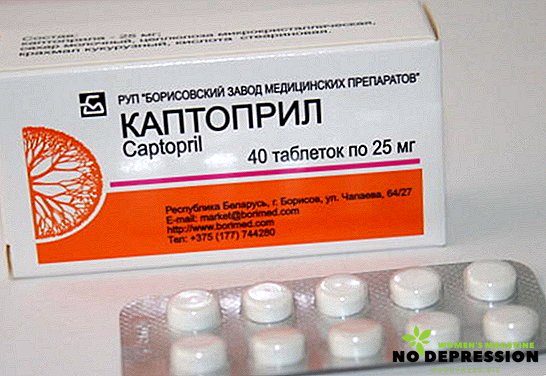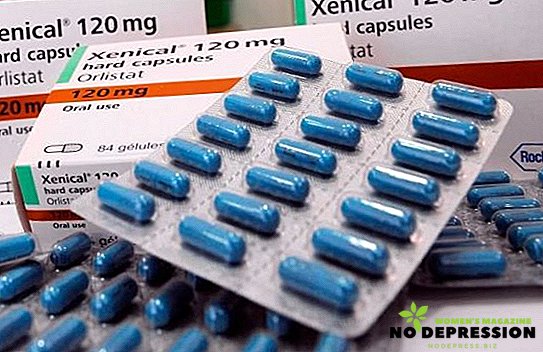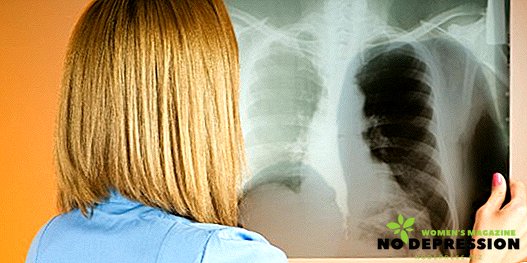Metabolic syndrome is a real epidemic in most civilized countries. Experts have been studying this pathology for many years. Unfortunately, it is not possible to cure MS for the time being, but with the right therapy, you can improve your health and avoid complications.

Danger of metabolic syndrome
This disorder is not a separate disease, it is a complex pathological changes that occur on the background of obesity in all body systems. As a result of metabolic disorders, the patient may simultaneously suffer from such diseases as:
- hypertension;
- obesity;
- diabetes;
- ischemia.
Such a "bunch" of pathologies is dangerous for a person, because it threatens with the development of the following serious consequences:
- vascular atherosclerosis;
- polycystic ovaries;
- gout;
- thrombosis;
- vascular stroke;
- myocardial infarction.
When MS cells stop to perceive the hormone insulin, with the result that he can not do his job. As a result, insulin resistance begins to develop, i.e., insulin insensitivity, as a result of which the cells poorly absorb glucose, serious changes occur in all tissues and organs.
According to statistics, the metabolic syndrome most often affects men, and the risk of developing this pathology in women increases five times during menopause and after it.
Separately, it should be noted that today this pathology is not treated. But with proper medical approach, proper nutrition, healthy lifestyle, it is possible to stabilize the condition for a long period.
Main reasons
Insulin in the body performs various functions. But his main task is to connect with the receptors located in the shell of each cell. After this, the transport of glucose from the intercellular space into the cell begins.
In other words, insulin helps glucose enter the cell. If the receptors for any reason do not respond to insulin, glucose begins to accumulate in the blood. The basis of the development of the metabolic syndrome is insulin insensitivity, that is, insulin resistance. This phenomenon can be caused by various reasons.
Genetic predisposition
In a number of people, insulin insensitivity is laid at the genetic level. Genes responsible for the development of metabolic syndrome are located on chromosome 19. Mutations in this case may be the reason that:
 cells lack receptors, which are responsible for communication with insulin;
cells lack receptors, which are responsible for communication with insulin;- the receptors become insensitive to insulin;
- the immune system itself begins to produce antibodies that block insulin-sensitive receptors;
- pancreas produces abnormal insulin.
There is a theory that a decrease in insulin sensitivity is the result of evolution. It is this property that helps the body to survive hunger. But in modern people with the consumption of high-calorie foods because of this, obesity and, as a result, metabolic syndrome develops.
High Fat and Carbohydrate Diet
Is the most important factor in the development of MS. Saturated fatty acids, which come along with animal fats, leads to obesity. In addition, fatty acids can cause serious changes in the membrane in the cell, making them insensitive to the action of insulin. And excessively high-calorie diet causes glucose and various acids to enter the blood in large quantities. Their excess is deposited in fat cells, subcutaneous fatty tissue, on tissues, which also causes a decrease in insulin sensitivity.
Other reasons include:
- Sedentary lifestyle. When physical activity decreases, the rate of all metabolic processes decreases. As a result, fatty acids block the entry of glucose into the cell, reduce the sensitivity of the cell membrane to insulin.
- Prolonged hypertension. In this case, peripheral circulation is disturbed.
- Addicted to low-calorie diet. If the caloric intake of the daily ration is less than 300 kcal, this becomes the cause of irreversible disturbances in the metabolism. The body begins to save, builds up reserves, which leads to a strong fat deposition.
- Stress. Prolonged mental stress leads to impaired nervous regulation of organs and tissues. This leads to disruptions in the production of hormones, including insulin.
- Long-term use of insulin antagonist drugs, such as glucagon, corticosteroids, oral contraceptives. These drugs reduce the absorption of glucose by the tissues, which causes a decrease in insulin sensitivity.
- Insulin overdose in the treatment of diabetes. When an incorrect dose is selected, a large amount of insulin accumulates in the blood. As a result, the receptors begin to get used to it. Insulin resistance in this case is a kind of protection of the body against a high concentration of insulin.
- Hormonal disorders. In women with increased production of testosterone, reducing estrogen fat begins to accumulate in the male type. As a result, the work of the vessels is disrupted, arterial hypertension may appear.
- A decrease in thyroid hormone levels in hypothyroidism can also cause an increased level of blood lipids and the development of insulin resistance.
- Age changes in men. With age, testosterone production begins to decrease, which can cause insulin resistance, hypertension, and obesity.
Symptoms of metabolic syndrome
The mechanism of development of this pathology is as follows:
- Improper diet and low physical activity lead to a violation of the sensitivity of receptors that interact with insulin.
- Then the pancreas begins to produce more insulin in order to overcome this insensitivity, to provide the cells with glucose.
- An excess of insulin in the blood develops. This can cause obesity, lipid metabolism disorders, high blood pressure.
- Not absorbed glucose remains in the bloodstream, which leads to hyperglycemia. When high concentration of glucose occurs, the destruction of proteins, the emergence of free radicals - they damage the cell wall and cause premature aging.
In this case, the disease begins to develop unnoticed, because it does not cause pain. From this MS becomes more dangerous. There are a number of subjective sensations that need attention:
 Bad mood with hunger. Due to low glucose intake in the brain cells, irritability and aggression attacks may appear.
Bad mood with hunger. Due to low glucose intake in the brain cells, irritability and aggression attacks may appear.- Increased fatigue. The breakdown is caused by the fact that the cells do not receive glucose and remain without an energy source. The reason for this fasting is that the mechanism responsible for transporting glucose does not work.
- Selectivity in food. For example, when meat and vegetables do not cause an appetite, but a person constantly wants sweets. This is due to the need for glucose. After consuming carbohydrates for a period of time, your mood may be better. And vegetables, protein foods cause drowsiness.
- Cardiopalmus. Increased insulin speeds up heartbeat. At the beginning, this leads to a thickening of the walls of the left half, then - to the wear of the muscular wall.
- Heartache. The deposition of cholesterol in the blood vessels leads to malnutrition of the heart and the appearance of pain.
- Headache, which is associated with constriction of the blood vessels of the brain. Capillary spasm occurs when blood pressure rises or due to vasoconstriction by atherosclerotic plaque.
- Nausea can be caused by increased intracranial pressure due to impaired blood flow from the brain.
- Thirst and dry mouth. It is the result of the suppression of the salivary glands with a high concentration of insulin in the blood.
- Tendency to constipation. Obesity of the organs and an increased level of insulin leads to a slowing down of the intestines, worsening the release of food juices. For this reason, food may linger for a long time in the digestive tract.
There are also some external manifestations of MS. For example, this is abdominal obesity, that is, the deposition of fat in the abdomen and shoulders. May appear "beer" belly. Remember that fatty tissue in this pathology accumulates both under the skin and around the internal organs. It not only squeezes them, making it difficult to work, but also performs the function of the endocrine organs. Fat secretes substances that can cause inflammation, increase the level of fibrin in the blood, which increases the risk of blood clots.
Abdominal obesity is diagnosed if the waist circumference exceeds:
- 102 cm - for men;
- 88 cm - for women.
There may also be red spots on the chest and neck - a sign of high blood pressure, which is associated with vascular spasms caused by an excess of insulin. Blood pressure indicators are most often the following:
- systolic, that is, the top, exceeds 130 mm Hg. v .;
- diastolic, that is, lower, exceeds 85 mm Hg. Art.
MS Diagnostics
The treatment of this disease is practiced by endocrinologists. However, taking into account the fact that a variety of pathological changes occur in the patient's body, consultation with a cardiologist and a nutritionist may be required. Diagnostics begins with a survey: at the reception, the specialist will collect anamnesis, will make a history of the disease.
And the following factors will help determine exactly what causes led to obesity and the development of MS:
- living conditions;
- food features;
- excess weight;
- whether relatives are obese;
- the presence of cardiovascular pathologies;
- blood pressure level.
Next, determine the type of obesity, for this the doctor examines the patient.
In metabolic syndrome, fat deposits are most often concentrated on the anterior abdominal wall, face, and body. With the ginoid - female type of obesity, those extra pounds can be deposited in the lower half of the body, on the thighs and buttocks. Doctors measure waist circumference.
About the development of MC can say the indications of waist circumference. A diagnosis is made if:
- waist more than 102 cm for men;
- more than 88 cm in women.

If there is a genetic predisposition, then the diagnosis of obesity is made with the following indicators:
- 94 cm - for men;
- 80 cm - for women.
Also measured is the ratio of waist circumference to hip circumference. This indicator should not exceed in men more than 1, in women - more than 0.8. For example, a woman has a waist circumference of 85 cm, a hip circumference of 100 cm. It is necessary to divide 85 by 100, resulting in 0.85. This indicator indicates obesity and the beginning of the development of MS.
Weighing and measuring growth. To calculate the body mass index, use the following formula: BMI = weight (kg) / height (m) x2
If the index is in the range of 25-30, you can talk about excess weight. But if the index value exceeds 30, this indicates obesity and the development of MS.
Laboratory diagnosis of metabolic syndrome
The doctor prescribes blood donation. The following indicators may indicate a problem:
- Total cholesterol exceeds 5.0 mmol / l. This can be caused by problems with lipid metabolism, the body's inability to absorb fats. High cholesterol levels can also be associated with elevated insulin levels, overeating.
- High molecular weight lipoproteins (HDL high density) are reduced to less than 1 mmol / l in men and less than 1.3 mmol / l in women. HDL is the "good" cholesterol, it dissolves, does not deposit on the walls of blood vessels.
- Low molecular weight lipoproteins (LDL, or low density cholesterol) are increased: more than 3.0 mmol / l. This cholesterol is also formed when there is an excess of insulin. It is slightly soluble, settles on the walls of blood vessels and forms atherosclerotic plaques.
- Triglycerides exceed 1.7 mmol / L. These are essential fatty acids that the body uses to transport fat. They enter the venous system from the tissue - with obesity, the concentration of this indicator increases.
- Fasting blood glucose is higher than 6.1 mmol / l. This suggests that the body is not able to absorb glucose, and its level remains high even after prolonged fasting.
- Insulin exceeds 6.5 mmol / l. With a high level of this hormone, one can speak of insulin insensitivity of tissues. With an increase in hormone production, the body tries to act on cell receptors for glucose uptake.
- Leptin increased to 15-20 ng / ml. This hormone is produced by adipose tissue and causes insulin resistance. The greater the obesity, the higher the concentration of this hormone
Medications for the treatment of metabolic syndrome
There are a number of drugs that are aimed at relieving the symptoms of those pathologies that are observed in metabolic syndrome.
For lipid metabolism disorders, the following apply.
Lipid-lowering drugs (statins and fibrates)
Needed to reduce intracellular cholesterol synthesis. Remove the "bad" cholesterol from the bloodstream, reduce the level of uric acid:
- Rosuvastatin. Take up to 10 mg of the drug once a day.

- Fenofibrate. The drug is taken 2 times a day: two capsules in the morning during breakfast and one capsule during dinner.
Insulin resistance treatment and blood sugar control
Using drugs to reduce insulin resistance, you can improve the flow of glucose into the cell, while not stimulating insulin production, slow down the production of fatty acids, speed up the processes of converting glucose to glycogen. Also, these drugs improve insulin's binding to cell receptors.
The most famous and effective drug is Metformin. The dosage depends on the level of glucose in the blood - on average, take 1-4 tablets per day. The dosage should be divided into 2-3 doses. Metformin is consumed after a meal.

Drugs that increase insulin sensitivity
They slow down the absorption of glucose from the intestines, reduce the production of glucose in the liver, increase insulin sensitivity. Most often, Siofor and Glucophage are prescribed. The initial dosage is 500-800 mg 2-3 times a day with meals. After 2-3 weeks, dose adjustment is necessary, taking into account the level of glucose in the blood.

Vitamins
Alpha-lipoic acid is necessary for the normalization of the liver, improving cholesterol metabolism. The most famous drug is alpha-lipon. Take 1 tablet up to 3 times per day for 4 weeks.

Preparations for the normalization of metabolism and blood pressure
Angiotensin converting enzyme inhibitors block the action of a substance that causes vasoconstriction. Facilitate the work of the heart, reduce pressure.
These include:
- Captopril Take on an empty stomach 3 times a day.

- Enalapril 0.01 g once a day, regardless of the meal.
Calcium antagonists or calcium channel blockers
Such drugs are necessary to lower blood pressure, reduce the oxygen demand of the heart muscle. May have a diuretic effect. Felodipine is usually prescribed. It needs to be taken once a day, 1 tablet.
Obesity treatment
Fat absorption inhibitors. Such drugs reduce the activity of digestive enzymes, regulate the breakdown and absorption of fats in the small intestine.
The most famous drugs:
- Xenical Take one capsule with each main meal or no later than an hour after meals.

- Orlistat Take 120 mg at mealtime three times a day.
Drugs that affect the central nervous system, suppress appetite
With their help, you can simulate eating behavior, reduce the need for food, reduce appetite. Fluoxetine is the best known drug. An antidepressant is prescribed up to 3 tablets per day after meals.
However, these drugs can not be used in the presence of excess weight, because they reduce the sensitivity of tissues to insulin. If they are prescribed, there must be 100% control of the attending specialist.
The importance of lifestyle adjustment in the treatment of MS
In order for the treatment of this pathology to bring a positive result, it is important to 100% change your lifestyle and food culture. Regular physical activity and a low carbohydrate diet is an effective combination that helps speed up the metabolism and increase the susceptibility of cells to insulin.
Physical activity
Regular physical therapy exercises contribute to the efficient burning of fat reserves, accelerate metabolic processes, increase insulin susceptibility of all tissues, organs, and produce a large amount of endorphins (happiness hormones that improve mood and help control appetite).
When practicing sports, follow a few simple rules that will most effectively deal with obesity problems:
- Training should be on a regular basis. When doing sports, remember about self-discipline, because your health depends on the right approach to physical activity. Do workouts 6 days a week for an hour. Also, classes should be fun - exercise through force is not recommended. For this reason, you need to choose the right training for you.
- When choosing a sport, consider your age and physical abilities. For example, a person over 50 is better to give preference to walking, Nordic walking. А вот молодым людям можно бегать трусцой. Для любого возраста идеально подойдут плавание в бассейне, катание на велосипеде. Также перечисленные виды спорта благотворно влияют на работу сердечно-сосудистой системы.
- Учитывайте и противопоказания по состоянию здоровья. Так, врачи рекомендуют временно отказаться от физической активности при наличии белка в крови, высоком артериальном давлении.
 Наиболее эффективны в борьбе с ожирением силовые и кардионагрузки, особенно если их регулярно чередовать. Анаэробные, то есть силовые упражнение, выполняются в быстром темпе, во время занятий приходится прилагать значительные усилия.
Наиболее эффективны в борьбе с ожирением силовые и кардионагрузки, особенно если их регулярно чередовать. Анаэробные, то есть силовые упражнение, выполняются в быстром темпе, во время занятий приходится прилагать значительные усилия.
Такие нагрузки хорошо подходят молодым людям, но противопоказаны тем, кто имеет проблемы с сердечно-сосудистой системой. В первое время продолжительность таких тренировок не должна превышать 15 минут в день, но с каждой последующей неделей можно увеличить продолжительность на 5-10 минут.
Аэробные упражнения, или кардиотренировки, выполняются с меньшей нагрузкой и интенсивностью. Но зато они улучшают работу легких и сердца, также подобные занятия способствуют сжиганию подкожного жира. К таким тренировкам относят танцы, занятия на беговой дорожке, велотренажере. Продолжение кардиотренировок в самом начале не должно превышать 15 минут, с течением времени их можно увеличивать.
Basics of proper nutrition
Низкоуглеводная диета - важный элемент при лечении МС. Современные диетологи не одобряют ни голодания, ни низкокалорийные диеты, ведь результат подобных методов недолговечен, также они имеют немало побочных эффектов.
Что касается низкоуглеводной диеты, то огромное количество разрешенных продуктов позволит сделать диетические блюда вкусными, а борьбу с ожирением - полезной и легкой. В идеале такая культура питания должна стать пожизненной, при этом с организмом произойдут положительные изменения: иммунитет повысится, нормализуется микрофлора кишечника.
Во избежание чувства голода нужно питаться небольшими порциями - около 5 раз в сутки, при этом организму нужно получать не менее 1600 калорий ежедневно. При низкоуглеводной диете объём потребляемых углеводов должен составлять не более 50% от всего рациона, причем необходимо заменить простые углеводы на сложные.
Также рекомендовано отказаться от соли, при этом иногда можно включать в свой рацион квашеную капусту, слабосоленую сельдь, малосольные огурцы. Для избавления от "плохого" холестерина на 1 порцию мяса должно приходиться 2 порции овощных блюд.
К разрешенным блюдам относят:
- Продукты из белковой группы. Это мясо нежирных сортов, яйца вареные, нежирные кисломолочные и молочные продукты, нежирный твердый сыр, запечённая морская рыба, овощи и фрукты. При этом последние можно употреблять в любом виде: в сыром, вареном, запеченном и т.д. Если говорить про ягоды, то лучше отдавать предпочтение несладким вариантам.
- Продукты углеводной группы. К ним относят перловку, гречку, рисовую крупу, хлеб с отрубями.
А вот следующие продукты запрещены при лечении МС:
- жирные сорта мяса;
- копчёные и консервированные продукты;
- жирные молочные продукты;
- сдобнвя выпечка;
- овсяная и манная крупа;
- маргарин и прочий жир, который используется в кулинарии;
- бананы, виноград, финики;
- сладкая газировка, соки с добавлением сахара.


 cells lack receptors, which are responsible for communication with insulin;
cells lack receptors, which are responsible for communication with insulin; Bad mood with hunger. Due to low glucose intake in the brain cells, irritability and aggression attacks may appear.
Bad mood with hunger. Due to low glucose intake in the brain cells, irritability and aggression attacks may appear.












